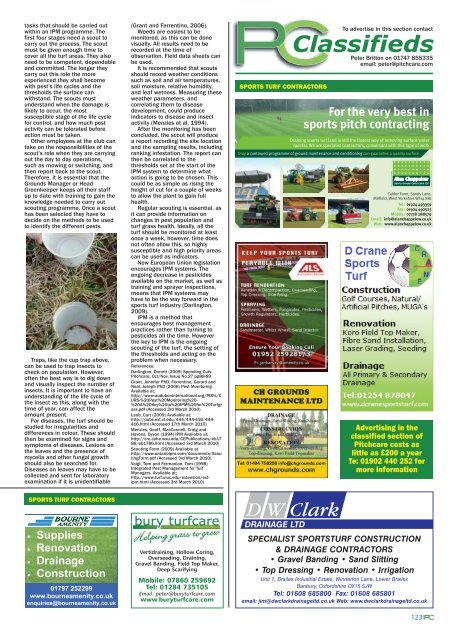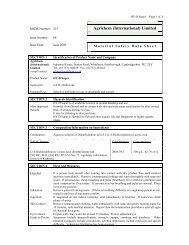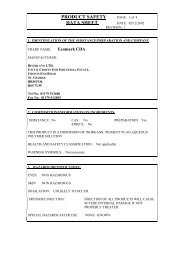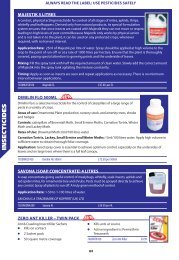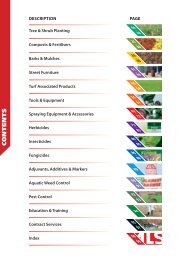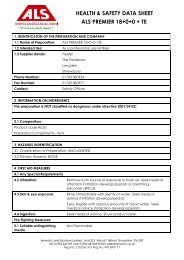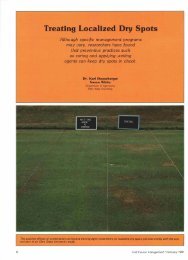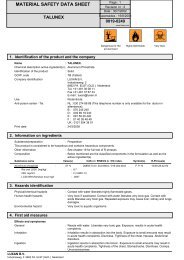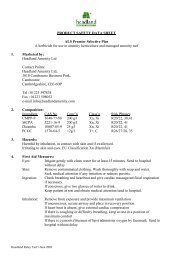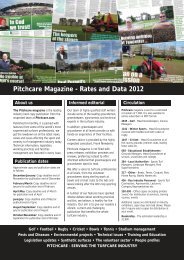Earning his Spurs - Pitchcare
Earning his Spurs - Pitchcare
Earning his Spurs - Pitchcare
Create successful ePaper yourself
Turn your PDF publications into a flip-book with our unique Google optimized e-Paper software.
tasks that should be carried out<br />
within an IPM programme. The<br />
first four stages need a scout to<br />
carry out the process. The scout<br />
must be given enough time to<br />
cover all the turf areas. They also<br />
need to be competent, dependable<br />
and committed. The longer they<br />
carry out t<strong>his</strong> role the more<br />
experienced they shall become<br />
with pest’s life cycles and the<br />
thresholds the surface can<br />
withstand. The scouts must<br />
understand when the damage is<br />
likely to occur, the most<br />
susceptible stage of the life cycle<br />
for control, and how much pest<br />
activity can be tolerated before<br />
action must be taken.<br />
Other employees at the club can<br />
take on the responsibilities of the<br />
scout’s role when they are carrying<br />
out the day to day operations,<br />
such as mowing or switching, and<br />
then report back to the scout.<br />
Therefore, it is essential that the<br />
Grounds Manager or Head<br />
Greenkeeper keeps all their staff<br />
up to date with training to gain the<br />
knowledge needed to carry out<br />
scouting programme. Once a scout<br />
has been selected they have to<br />
decide on the methods to be used<br />
to identify the different pests.<br />
Traps, like the cup trap above,<br />
can be used to trap insects to<br />
check on population. However,<br />
often the best way is to dig down<br />
and visually inspect the number of<br />
insects. It is important to have an<br />
understanding of the life cycle of<br />
the insect as t<strong>his</strong>, along with the<br />
time of year, can affect the<br />
amount present.<br />
For diseases, the turf should be<br />
studied for irregularities and<br />
differences in colour. These should<br />
then be examined for signs and<br />
symptoms of diseases. Lesions on<br />
the leaves and the presence of<br />
mycelia and other fungal growth<br />
should also be searched for.<br />
Diseases on leaves may have to be<br />
collected and sent for laboratory<br />
examination if it is unidentifiable<br />
SPORTS TURF CONTRACTORS<br />
• Supplies<br />
• Renovation<br />
• Drainage<br />
• Construction<br />
01797 252299<br />
www.bourneamenity.co.uk<br />
enquiries@bourneamenity.co.uk<br />
(Grant and Ferrentino, 2006).<br />
Weeds are easiest to be<br />
monitored, as t<strong>his</strong> can be done<br />
visually. All results need to be<br />
recorded at the time of<br />
observation. Field data sheets can<br />
be used.<br />
It is recommended that scouts<br />
should record weather conditions<br />
such as soil and air temperatures,<br />
soil moisture, relative humidity,<br />
and leaf wetness. Measuring these<br />
weather parameters, and<br />
correlating them to disease<br />
development, could produce<br />
indicators to disease and insect<br />
activity (Menzies et al, 1994).<br />
After the monitoring has been<br />
concluded, the scout will produce<br />
a report recording the site location<br />
and the sampling results, including<br />
ranking infestation. The report can<br />
then be correlated to the<br />
thresholds set at the start of the<br />
IPM system to determine what<br />
action is going to be chosen. T<strong>his</strong><br />
could be as simple as rising the<br />
height of cut for a couple of weeks<br />
to allow the plant to gain full<br />
health.<br />
Regular scouting is essential, as<br />
it can provide information on<br />
changes in pest population and<br />
turf grass health. Ideally, all the<br />
turf should be monitored at least<br />
once a week, however, time does<br />
not often allow t<strong>his</strong>, so highly<br />
susceptible and high priority areas<br />
can be used as indicators.<br />
New European Union legislation<br />
encourages IPM systems. The<br />
ongoing decrease in pesticides<br />
available on the market, as well as<br />
training and sprayer inspections,<br />
means that IPM systems may<br />
have to be the way forward in the<br />
sports turf industry (Darlington,<br />
2009).<br />
IPM is a method that<br />
encourages best management<br />
practices rather than turning to<br />
pesticides all the time. However<br />
the key to IPM is the ongoing<br />
scouting of the turf, the setting of<br />
the thresholds and acting on the<br />
problem when necessary.<br />
References:<br />
Darlington, Everett (2009) Spending Cuts.<br />
<strong>Pitchcare</strong>, Oct/Nov, Issue No.27 pp88-89<br />
Grant, Jennifer PhD, Ferrentino, Gerard and<br />
Neal, Joseph PhD (2006) Pest Monitoring<br />
Available at;<br />
http://www.auduboninternational.org/PDFs/C<br />
URS-%20Pest%20Monitoring%20-<br />
%20A%20Key%20to%20IPM%20for%20Turfgr<br />
ass.pdf (Accessed 3rd March 2010)<br />
Laub, Curt (2009) Available at;<br />
http://pubs.ext.vt.edu/444/444-416/444-<br />
416.html (Accessed 17th March 2010)<br />
Menzies, Geoff, MacConnell, Craig and<br />
Havens, Dyvon (1994) IPM Available at;<br />
http://cru.cahe.wsu.edu/CEPublications/eb17<br />
86/eb1786.html (Accessed 3rd March 2010)<br />
Scouting Form (2009) Available at<br />
http://www.ontarioipm.com/documents/Scou<br />
tingForm.pdf (Accessed 3rd March 2010)<br />
Voigt, Tom and Fermanian, Tom (1998)<br />
Integrated Pest Management for Turf<br />
Managers. Available at;<br />
http://www.turf.uiuc.edu/extension/extipm.html<br />
(Accessed 3rd March 2010)<br />
Vertidraining, Hollow Coring,<br />
Overseeding, Draining,<br />
Gravel Banding, Field Top Maker,<br />
Deep Scarifying<br />
Mobile: 07860 259692<br />
Tel: 01284 735105<br />
Email: peter@buryturfcare.com<br />
www.buryturfcare.com<br />
SPORTS TURF CONTRACTORS<br />
D W Clark<br />
DRAINAGE LTD<br />
To advertise in t<strong>his</strong> section contact<br />
Classifieds<br />
Peter Britton on 01747 855335<br />
email: peter@pitchcare.com<br />
���������������������<br />
������������������������<br />
�����������������������������������������������������������������������������<br />
�������������������������������������������������������������������������<br />
�������������������������������������������������������������������������������������������������<br />
Sports Ground Contractors Ltd<br />
�������������������������<br />
��������������������������������<br />
�������������������<br />
��������������������<br />
����������������������<br />
����������������������������������<br />
�����������������������������<br />
Advertising in the<br />
classified section of<br />
<strong>Pitchcare</strong> costs as<br />
little as £200 a year<br />
Te: 01902 440 252 for<br />
more information<br />
SPECIALIST SPORTSTURF CONSTRUCTION<br />
& DRAINAGE CONTRACTORS<br />
• Gravel Banding • Sand Slitting<br />
• Top Dressing • Renovation • Irrigation<br />
Unit 7, Brailes Industrial Estate, Winderton Lane, Lower Brailes<br />
Banbury, Oxfordshire OX15 5JW<br />
Tel: 01608 685800 Fax: 01608 685801<br />
email: jim@dwclarkdrainageltd.co.uk Web: www.dwclarkdrainageltd.co.uk<br />
123


